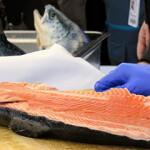Public health could - and should - should play bigger role in US fisheries policy
U.S. dietary guidelines call for Americans to eat more fish. But fishery managers don’t usually manage stocks with this goal in mind, according to a recent study.
Fisheries policy is essentially part of the nation’s food policy, which affects public health. So, fishery managers, whether they mean to or not, affect the availability, access and distribution of healthy seafood for Americans nationwide.
Despite this intrinsic link, fishery managers don’t usually take public health into account, the researchers said.
The primary authors of the study published in June were Dave Love, an associate scientist at Johns Hopkins University’s Center for a Livable Future, and Patricia Pinto da Silva, a social scientist at the Northeast Fisheries Science Center, which is part of the National Oceanic and Atmospheric Administration.
“Fisheries managers should consider how management decisions affect markets, access and use of seafood,” the researchers told SeafoodSource in an email.
The Magnuson-Stevens Act, which is the main fisheries management law in the U.S., requires fisheries to be managed to produce the greatest benefits to the nation in terms of food production, within environmental constraints.
“However, while this is a key component of the [law], fisheries are generally not managed with food production in mind,” the researchers said.
Current fisheries management doesn’t take into account what the fish is used for once it’s caught, or where it goes. This means that it’s impossible to know if the country is meeting optimum yield, the researchers said.
Part of this disconnect comes from the fact that fisheries policymakers and public health officials are literally in different federal departments: Commerce for fisheries and Health and Human Services for public health. Federal agencies do cooperate on seafood inspection.
The researchers recommend fostering better collaboration between fisheries and health agencies.
“The public health and medical community needs to seek out information from the fisheries community about the ecological health of a resource before they make recommendations about what seafood consumers should eat,” they said.
Methods and criteria for cooperating better have been assessed in Europe, where the European Environmental Agency recently released a report assessing seafood sustainability, using a framework developed by the National Research Council and others in 2015.
A similar coordination gap faces terrestrial food producers. While the Food and Drug Administration and U.S. Department of Agriculture have food safety regulations for farms and processors to reduce foodborne diseases, in many cases, budget decisions for national farm policy — such as allocation of farm subsidies and access to crop insurance — don’t take into account human health.
The U.S. currently imports roughly 90 percent of its seafood and much of country’s domestic catch is exported. In addition, not all the fish caught in the U.S. is used for human consumption. The researchers said the country could increase the amount of U.S.-caught fish available for domestic consumers without U.S. fishermen having to up their catches.
“Changes in how we fish and what we do with it could contribute to providing more fish to U.S. consumers without increasing landings,” they said.
Farmed and wild fish will play different roles in increasing seafood availability, according to the research. Aquaculture offers a steady supply of uniform products, while the diversity of wild fish works well for regional fishmongers, restaurants and buyers that don’t mind variation in size and timing of fish, the researchers said.
Government agencies, universities, hospitals and other large institutions have enormous buying power, and can leverage that by buying seafood from well-managed fisheries, the researchers said.
For instance, government nutrition assistance programs feed more than 100 million adults and children per year. One of the biggest, the National School Lunch program, spends USD 12.5 billion (EUR 11.2 billion) per year, but only USD 7.5 million (EUR 6.7 million) on seafood.
“This presents a huge opportunity to leverage the purchasing power of the federal government to support the domestic fishing industry and to help food insecure populations as well as the general public meet their recommended dietary consumption of fish,” the researchers said.
In Alaska, officials have proactively worked to navigate bureaucratic hurdles – including getting funding from state and federal agencies for the local fish – to get local pollock, salmon, cod, halibut, and rockfish into school cafeterias. The Fish-to-School program is popular with parents and has helped the community meet national dietary guidelines in fish consumption.
To emulate that success, fisheries managers will have to look at the current system through a food system perspective.
“We need more information about what happens to fish once it is landed. What is it used for and where does it go?” the researchers said. “You have to look beyond the landing dock and see how the fish we catch is connected to our markets, communities, local economies and public health.”






Share